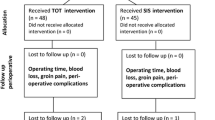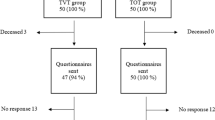Abstract
Introduction
To compare the efficacy, safety and complications of the trans-obturator midurethral sling from inside to outside (TVT-O) and of the shorter trans-obturator midurethral sling (TVT-Abbrevo) for treatment of female SUI.
Materials and methods
One hundred fifty-eight recruited patients were randomized into either the TVT-O or TVT-Abbrevo group. Preoperative assessment included history and general assessment, urinalysis and urine culture, urogynaecological clinical examination, urodynamic evaluation and urogynaecologic interview by ICIQ-SF-UI, PGI-I and PISQ12. Operative time, perioperative complications, spontaneous voiding, postoperative complications and hospital stay were prospectively recorded in all patients. At 3, 6, 12, 24 and 36 months after surgery, patients were asked to answer urogynaecological interviews by ICIQ-SF-UI, PGI-I and PISQ12. The urodynamic assessment was performed at 12, 24 and 36 months. Success rate was assessed at 12, 24 and 36 months postoperatively.
Results
Overall, 138 of 158 patients (87%) were cured of SUI 36 months after the operation with no significant differences between groups [69 (87%) and 69 (87%) patients in the TVT-O and TVT Abbrevo groups, respectively]. The two groups did not significantly differ in operative time, intraoperative blood loss and length of hospital stay. Nine patients (11%) had postoperative groin pain in the TVT-O group and one patient in the TVT Abbrevo group (p = 0.02). Three-year control demonstrated an equal objective cure rate in both groups. There was a significant improvement in total PISQ-12 and ICIQ-SF-UI scores in both groups at 36 months FU.
Conclusion
TVT-Abbrevo has similar efficacy and safety compared with TVT-O in women with SUI; the use of a shorter sling reduces postoperative pain.

Similar content being viewed by others
References
Haylen BT, de Ridder D, Freeman RM, Swift SE, Berghmans B, Lee J, et al. An International Urogynecological Association (IUGA)/International Continence Society (ICS) joint report on the terminology for female pelvic floor dysfunction. Int Urogynecol J. 2010;21(1):5–26.
Norton P, Brubaker L. Urinary incontinence in women. Lancet. 2006;367:57–67.
Ulmsten U, Falconer C, Johnson P, Jomaa M, Lannér L, Nilsson CG, et al. A multicenter study of tension-free vaginal tape (TVT) for surgical treatment of stress urinary incontinence. Int Urogynecol J Pelvic Floor Dysfunct. 1998;9(4):210–3.
Angioli R, Plotti F, Muzii L, Montera R, Panici PB, Zullo MA. Tension-free vaginal tape versus transobturator suburethral tape: five-year follow-up results of a prospective, randomised trial. Eur Urol. 2010;58(5):671–7.
Ford AA, Rogerson L, Cody JD, Aluko P, Ogah JA. Mid-urethral sling operations for stress urinary incontinence in women. Cochrane Database Syst Rev. 2017;7:CD006375.
Zullo MA, Plotti F, Calcagno M, Marullo E, Palaia I, Bellati F, et al. One-year follow-up of tension-free vaginal tape (TVT) and trans-obturator suburethral tape from inside to outside (TVT-O) for surgical treatment of female stress urinary incontinence: a prospective randomised trial. Eur Urol. 2007;51(5):1376–82.
Ford AA, Rogerson L, Cody JD, Aluko P, Ogah J. Mid-urethral sling operations for stress urinary incontinence in women. Cochrane Database Syst Rev. 2017: 7.
Shaw JS, Jeppson PC, Rardin CR. Decreasing transobturator sling groin pain without decreasing efficacy using TVT-Abbrevo. Int Urogynecol J. 2015;26(9):1369–72.
Avery K, Donovan J, Peters TJ, Shaw C, Gotoh M, Abrams P. ICIQ: a brief and robust measure for evaluating the symptoms and impact of urinary incontinence. Neurourol Urodyn. 2004;23(4):322–30.
Rogers RG, Coates KW, Kammerer-Doak D, Khalsa S, Qualls C. A short form of the pelvic organ prolapse/urinary incontinence sexual questionnaire (PISQ-12). Int Urogynecol J Pelvic Floor Dysfunct. 2003;14:164–8.
Cogan SL, Weber AM, Hammel JP. Is urethral mobility really being assessed by the pelvic organ prolapse quantification (POP-Q) system? Obstet Gynecol. 2002;99(3):473–6.
Gammie A, Clarkson B, Constantinou C, Damaser M, Drinnan M, Geleijnse G, et al. International Continence Society urodynamic equipment working group. International Continence Society guidelines on urodynamic equipment performance. Good urodynamic practices: uroflowmetry, filling cystometry, and pressure-flow studies. Neurourol Urodyn. 2002;21(3):261–74.
de Leval J, Waltregny D. New surgical technique for treatment of stress urinary incontinence TVT-obturator: new developments and results. Surg Technol Int. 2005;14:212–21.
Waltregny D, de Leval J. New surgical technique for treatment of stress urinary incontinence TVT-ABBREVO from development to clinical experience. Surg Technol Int. 2012;22:149–57.
Yalcin I, Bump RC. Validation of two global impression questionnaires for incontinence. Am J Obstet Gynecol. 2003;189:98–101.
Haylen BT, Freeman RM, Swift SE, Cosson M, Davila GW, Deprest J, et al. International Urogynecological Association; International Continence Society; joint IUGA/ICS working group on complications terminology. An International Urogynecological Association (IUGA)/International Continence Society (ICS) joint terminology and classification of the complications related directly to the insertion of prostheses (meshes, implants, tapes) and grafts in female pelvic floor surgery. Neurourol Urodyn. 2011;30(1):2–12.
Blaivas JG, Groutz A. Bladder outlet obstruction nomogram for women with lower urinary tract symptomatology. Neurourol Urodyn. 2000;19(5):553–64.
Delorme E. Transobturator urethral suspension: miniinvasive procedure in the treatment of stress urinary incontinence in women. Prog Urol. 2001;11:1306–13.
De Leval J. Novel surgical technique for the treatment of female stress urinary incontinence: transobturator vaginal tape inside-out. Eur Urol. 2003;44:724–30.
Fischer A, Fink T, Zachmann S, Eickenbusch U. Comparison of retropubic and outside-in transobturator sling systems for the cure of female genuine stress urinary incontinence. Eur Urol. 2005;48:799–804.
Sung VW, Schleinitz MD, Rardin CR, et al. Comparison of retropubic vs transobturator approach to midurethral slings: a systematic review and meta-analysis. Am J Obstet Gynecol. 2007;197:3–11.
Canel V, Thubert T, Wigniolle I, Fernandez H, Deffieux X. Postoperative groin pain and success rates following transobturator midurethral sling placement: TVT ABBREVO® system versus TVT™ obturator system. Int Urogynecol J. 2015;26(10):1509–16.
Schiavi MC, D’Oria O, Aleksa N, Vena F, Prata G, Di Tucci C, et al. Usefulness of Ospemifene in the treatment of urgency in menopausal patients affected by mixed urinary incontinence underwent mid-urethral slings surgery. Gynecol Endocrinol. 2019;35(2):155–9.
Kurien A, Narang S, Han HC. Tension-free vaginal tape-Abbrevo procedure for female stress urinary incontinence: a prospective analysis over 22 months. Singap Med J. 2017;58(6):338–42.
Hubka P, Nanka O, Masata J, Martan A, Svabik K. TVT ABBREVO: cadaveric study of tape position in foramen obturatum and adductor region. Int Urogynecol J. 2016;27(7):1047–50.
Li WL, Lu ZW, Li FP, Yu HY. A comparative study on treating femal stress urinary incontinence with TVT-Abbrevo and TVT-obturator. Zhonghua Yi Xue Za Zhi. 2016;96(28):2238–40.
de Leval J, Thomas A, Waltregny D. The original versus a modified inside-out transobturator procedure: 1-year results of a prospective randomized trial. Int Urogynecol J 2011;22(2):145–156. doi: https://doi.org/10.1007/s00192-010-1264-4..
Schiavi MC, Zullo MA, Faiano P, et al. Retrospective analysis in 46 women with vulvovaginal atrophy treated with ospemifene for 12 weeks: improvement in overactive bladder symptoms. Gynecol Endocrinol. 2017;11:1–4.
Fürst RV, Bezerra CA, Glina S. Female sexual function following surgical treatment of stress urinary incontinence: systematic review and meta-analysis. Sex Med Rev. 2018;6(2):224–33.
Schiavi MC, Savone D, Di Mascio D, Di Tucci C, Perniola G, Zullo MA, et al. Long-term experience of vaginal vault prolapse prevention at hysterectomy time by modified McCall culdoplasty or Shull suspension: Clinical, sexual and quality of life assessment after surgical intervention. Eur J Obstet Gynecol Reprod Biol. 2018;223:113–8.
Author information
Authors and Affiliations
Corresponding author
Ethics declarations
Conflicts of interest
None.
Additional information
Publisher’s note
Springer Nature remains neutral with regard to jurisdictional claims in published maps and institutional affiliations.
Rights and permissions
About this article
Cite this article
Zullo, M.A., Schiavi, M.C., Luffarelli, P. et al. TVT-O vs. TVT-Abbrevo for stress urinary incontinence treatment in women: a randomized trial. Int Urogynecol J 31, 703–710 (2020). https://doi.org/10.1007/s00192-019-04077-7
Received:
Accepted:
Published:
Issue Date:
DOI: https://doi.org/10.1007/s00192-019-04077-7




